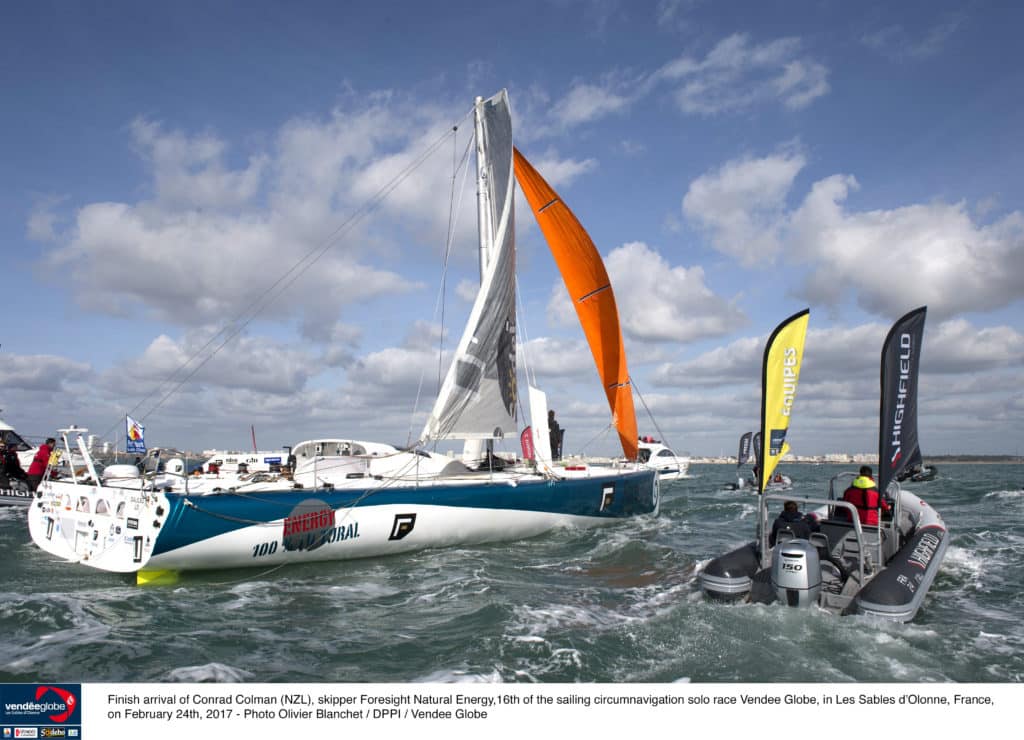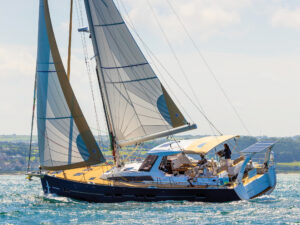
SAILING – VENDEE GLOBE 2017 – MISCS ARRIVALS
It was more than mere survival instinct that kept Kiwi Conrad Colman battling to the bitter end of his Vendée Globe solo, nonstop, round-the-world race. At some 715 miles, or about three days, before he was expected to finish, the mast of his boat, Foresight Natural Energy, came crashing down at around 2200 UTC on February 10.
Colman had already overcome too many challenges to throw in the towel so close to home, to let a dream expire, when the spar went over the side in huge seas and 35- to 40-knot winds, 250 miles west of Lisbon, Portugal. His life had been dominated for the past dozen years by his drive to compete in solo ocean racing’s pinnacle event. The pursuit of the Vendée Globe required him to move from the United States to Brittany, France, and recently saw him mortgage his financial future and that of his hugely supportive wife, Clara, in order to make the starting line.
Once he had managed to cut the worst of the rig debris free, Colman, who celebrated his 33rd birthday in December, during the race, could do nothing. Conditions remained dangerous for two days. Even so, there was never a moment for brooding regrets. Rest was essential, and Colman did all he could to sleep. Between naps, he made a plan of how he would step his boom as a jury rig, set a remaining portion of his mainsail and fashion a jib from his storm sail.
Two further complications compounded his situation. He was attempting to complete the race as the first-ever skipper to use only sustainable energy sources — hydro and solar power — and strictly no fossil fuels at all, and the slow speeds and gray overhead conditions meant he would soon run short of power. And Colman, a strict vegetarian, was already very low on food and had been rationing his remaining supply for several days.
The first task was to make a composite repair to the carbon boom, which had been crushed when the mast collapsed and went over the side. Thereafter it was another 48 hours before Colman could step the boom as a mast. It was on Valentine’s Day, the day he had hoped to cross the line for a romantic reunion with his wife, that he got the mast stepped. During the preceding decade, Colman worked to build his armory of skills as a sailmaker and race-team shore crew member. All of his skills came into play during his rig repair.
Turning the sail 90 degrees, he used the second reef reinforcements for the head and the tack, and another existing reinforcement became the new clew. The leech of the old mainsail was now the foot of the new sail.
“I spread out the new edges as best I could, rubbed the salt off with my clothes, laid down long rows of double-sided tape and then taped over the seam again for security,” reported Colman while he was still at sea. “Reinforcements were placed where the sail would be tied onto the boom, which was now the mast. I cut out a batten pocket from another piece of the sail and glued it down with flexible epoxy. It sounds simple, but it took me a whole day. As the forecast was thankfully for mainly running and reaching until Les Sables, I spent a little extra time to make a square head for the main, which gave me a little extra surface area. I think it’s the only square-headed main in the history of jury rigs!
“I was working in such a cramped space that I never saw the whole sail at once until the mast was up,” Colman continued. “That’s also because I tied the main to the mast instead of making a halyard to hoist it after the new mast was in place. That added a lot of weight when I had to put the whole lot on my shoulder to help hoist it vertically. In comparison, the storm jib was easy. Simply unfurl, change the luff cable and hoist.”
Colman had more than 72 hours of very mixed winds and sailed as close to the contrary northeasterly wind as he could. He then spent 36 hours almost completely becalmed. Finally the wind swung to the north and northwest. That the “Crazy Kiwi” — the moniker he used — spent hours working out clever sheeting arrangements, with a spiderweb of rope and Spanish windlasses to flatten his main and gain a hard leech, was typical of his drive and spirit.
Colman’s heroic welcome back to Les Sables d’Olonne was huge and emotional, with hundreds of fans lining the entrance channel and in the spectator fleet. He had simply invested too much of himself in the Vendée Globe to fail. Once ashore, he revealed that additional motivation had come from memories of his brother who had died two years earlier and the legacy of his father, who died falling from a mast when Conrad was 11 months old.
Colman’s race ended with an epic adventure. But he had already proved able to punch above the potential of his untested, older boat and his shoestring budget by sailing fast, smart and capably. He plans to be back in 2020.








